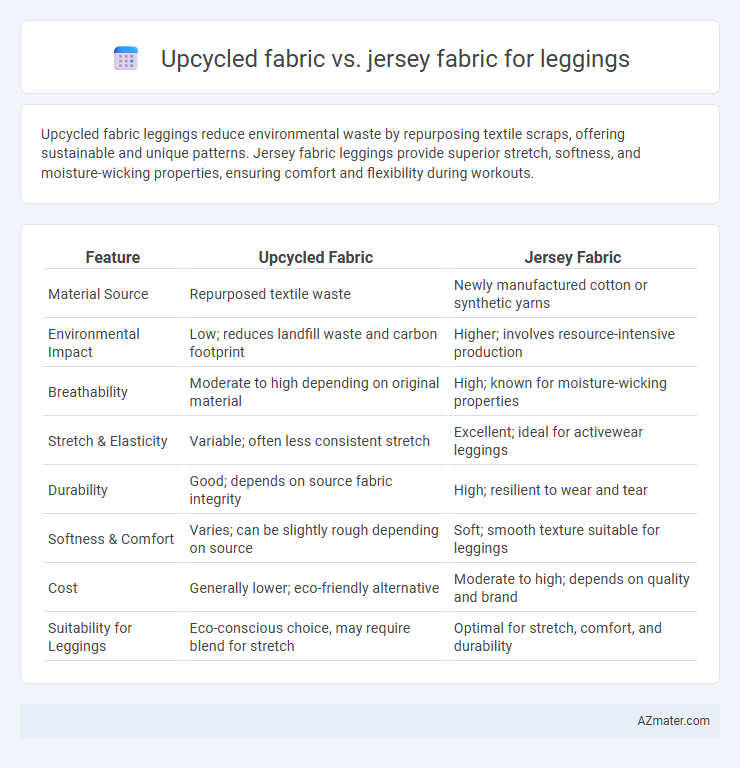Upcycled fabric leggings reduce environmental waste by repurposing textile scraps, offering sustainable and unique patterns. Jersey fabric leggings provide superior stretch, softness, and moisture-wicking properties, ensuring comfort and flexibility during workouts.
Table of Comparison
| Feature | Upcycled Fabric | Jersey Fabric |
|---|---|---|
| Material Source | Repurposed textile waste | Newly manufactured cotton or synthetic yarns |
| Environmental Impact | Low; reduces landfill waste and carbon footprint | Higher; involves resource-intensive production |
| Breathability | Moderate to high depending on original material | High; known for moisture-wicking properties |
| Stretch & Elasticity | Variable; often less consistent stretch | Excellent; ideal for activewear leggings |
| Durability | Good; depends on source fabric integrity | High; resilient to wear and tear |
| Softness & Comfort | Varies; can be slightly rough depending on source | Soft; smooth texture suitable for leggings |
| Cost | Generally lower; eco-friendly alternative | Moderate to high; depends on quality and brand |
| Suitability for Leggings | Eco-conscious choice, may require blend for stretch | Optimal for stretch, comfort, and durability |
Introduction to Upcycled and Jersey Fabrics
Upcycled fabric, derived from repurposed textile waste, offers a sustainable alternative ideal for eco-conscious legging production, reducing environmental impact by minimizing textile landfill contributions. Jersey fabric, commonly used in activewear leggings, is a soft, stretchy knit textile typically made from cotton, polyester, or blends, prized for comfort, flexibility, and breathability. Choosing between upcycled and jersey fabrics depends on sustainability goals and performance needs, with upcycled fabrics promoting circular fashion and jersey fabrics delivering reliable elasticity and moisture management.
What is Upcycled Fabric?
Upcycled fabric is created by repurposing pre-existing textiles or garment waste into new material, reducing environmental impact and minimizing textile waste in production. Unlike jersey fabric, which is a knit textile typically made from cotton, polyester, or blends designed for stretch and comfort, upcycled fabric emphasizes sustainability by diverting resources from landfills. Leggings made from upcycled fabric combine eco-consciousness with performance, offering a guilt-free alternative to traditional jersey legging materials.
What is Jersey Fabric?
Jersey fabric is a soft, stretchy knit textile commonly made from cotton or synthetic fibers like polyester, making it ideal for leggings due to its breathability and flexibility. This fabric provides excellent moisture-wicking properties and a smooth texture that enhances comfort during physical activities. Compared to upcycled fabric, jersey offers consistent quality and durability specifically engineered for activewear performance.
Environmental Impact: Upcycled vs Jersey
Upcycled fabric for leggings significantly reduces textile waste by repurposing existing materials, leading to lower carbon emissions and water consumption compared to conventional jersey fabric production. Jersey fabric, typically made from virgin cotton or synthetic fibers, involves intensive resource use and contributes to environmental degradation through chemical treatments and energy-intensive manufacturing processes. Choosing upcycled fabric supports circular fashion practices and minimizes landfill impact, making it a more sustainable option for eco-conscious consumers.
Comfort and Breathability Comparison
Upcycled fabric leggings often feature a blend of natural fibers and recycled materials, enhancing breathability and moisture-wicking properties, making them comfortable for extended wear. Jersey fabric, known for its soft, stretchy knit structure, offers excellent elasticity and snug fit but may retain heat more than lightweight upcycled blends. Choosing between upcycled fabric and jersey fabric for leggings depends on prioritizing eco-friendly moisture management or traditional soft stretch comfort.
Durability and Longevity
Upcycled fabric for leggings offers enhanced durability due to its recycled fibers often undergoing rigorous quality checks, ensuring strong wear resistance and reduced environmental impact. Jersey fabric, typically made from cotton or synthetic blends, provides excellent stretch and comfort but may experience faster wear and pilling over time compared to upcycled options. Choosing upcycled fabric supports sustainable fashion without compromising the longevity and durability essential for activewear leggings.
Style and Design Versatility
Upcycled fabric offers unique, eco-friendly patterns that enhance the individuality and sustainability of leggings, making each piece a statement in style and environmental consciousness. Jersey fabric excels in design versatility with its smooth texture and four-way stretch, allowing for sleek, form-fitting shapes and a wide range of color options. Combining upcycled fabric's distinctiveness with jersey's flexibility can elevate legging designs to be both fashionable and functional.
Cost and Accessibility
Upcycled fabric for leggings offers a cost-effective and eco-friendly alternative by repurposing pre-existing materials, often resulting in lower production expenses and reduced environmental impact compared to new textiles. Jersey fabric, widely available and produced through traditional methods, tends to have a consistent price range and greater accessibility in retail and wholesale markets due to its established supply chains. Choosing upcycled fabric emphasizes sustainability and affordability, while jersey fabric provides ease of sourcing and dependable quality for legging manufacturers.
Performance in Activewear Leggings
Upcycled fabric in activewear leggings offers sustainability benefits while maintaining durability and moisture-wicking properties essential for performance. Jersey fabric provides excellent stretch, breathability, and softness, making it ideal for flexibility and comfort during workouts. Both fabrics support high-performance activities, but jersey typically delivers superior elasticity and temperature regulation for intense training sessions.
Which Fabric is Better for Leggings?
Upcycled fabric offers sustainable benefits by reducing waste and often includes unique textures, making it an eco-friendly choice for leggings. Jersey fabric, known for its softness, stretchability, and moisture-wicking properties, provides superior comfort and flexibility ideal for activewear. Choosing the better fabric depends on priorities: jersey excels in performance and comfort, while upcycled fabric emphasizes environmental impact and individuality.

Infographic: Upcycled fabric vs Jersey fabric for Legging
 azmater.com
azmater.com